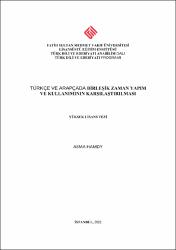Türkçe ve Arapçada Birleşik Zaman Yapım ve Kullanımının Karşılaştırılması
Citation
HAMDY, Asma, Türkçe ve Arapçada Birleşik Zaman Yapım ve Kullanımının Karşılaştırılması, Fatih Sultan Mehmet Vakıf Üniversitesi Lisansüstü Eğitim Enstitüsü Türk Dili Ve Edebiyatı Anabilim Dalı Türk Dili Ve Edebiyatı Programı, Yayımlanmamış Yüksek Lisans Tezi, İstanbul 2021.Abstract
Bu çalışmada “Türkçe Ve Arapçada Birleşik Zaman Yapım Ve Kullanımının Karşılaştırılması” başlığı altında, Türkçe ve Arapçada zaman ve görünüş yapıları ele alınmış, her iki dile dair dilbilgisi kitaplarında bu konularla ilgili tartışmalar üzerinde durulmuş ve bu yapıların bu iki dilde yapı olarak nasıl karşılandığı ortaya konulmaya çalışılmıştır. Tezin amacı Türkçedeki birleşik zaman yapısının Arapçaya çevrilmesi konusunda bir yöntem ortaya koymaktır.Bunun için zaman ve birleşik zaman teşkilindenki yapısal unsurlar saptanmış, görünüş ve kiplik kavramları üzerinde durulmuş; her iki dildeki birleşik zaman çözümlemesi için gerekli hususlardan olay zamanı, konuşma zamanı ilişkilerine de yer verilmiştir. Tezde kullanılan teknik, Türkçede zaman ve birleşik zaman yapılarının ifade ettiği anlam, zaman ve görünüşü inceleyerek bu yapıların Arapçada nasıl karşılanabileceğini örneklerle açıklamaktır. Bu konudaki genel değerlendirmeler, Türk dilindeki zaman ve görünüş yapılarının Arapçada karşılanması hususunda dikkat edilmesi gereken hususlar Sonuç kısmında açıklanmıştır. This study, under the title of "Comparison of compound tenses and usage in Turkish and Arabic languages". The focal point of this research is to discuss tense and aspect structures in Turkish and Arabic languages. We were more sensitive about researches on these issues in grammar books of both languages and tried to reveal how these structures were compared in the two languages.
The aim of this thesis is to present a method for translating the compound tense structure from Turkish into Arabic. In order to achieve this purpose, the structural elements in the formation of tense and compound tense are analyzed, the concepts of aspect and modality are emphasized; Event time and speech time relations, which are necessary for the combined tense analysis in both languages, are also included. The technique used in the thesis is to explore the meaning, tense, and aspect of tenses and compound tenses in Turkish and to explain with examples how these structures can be resembled in Arabic.
In the conclusion section, the general assessments on this topic are explained as well as the points that should be taken into consideration about the structures of tenses and aspects in the Turkish language and their equivalent in the Arabic language.



















